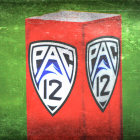
There is an unwritten protocol amid the savagery of realignment: It's no problem to cause the systematic collapse of a century old athletic conference -- business is business and all that -- but good luck trying to get someone to own up to it.
That's one item missing from the tragic, ugly death spiral of the Pac-12. As the inevitable lurched forward in recent days, everyone involved was seeking cover -- not wanting to be seen as the one pulling the thread that unraveled the Pac-12.
Colorado was first to depart for the Big 12 last week, but Oregon and Washington made the biggest dent Friday in moving to the Big Ten. (Notice how both went together so as not to isolate "blame" on a single school.) The Big 12 had already voted to accept Arizona with Arizona State and Utah following close behind.
For all intents and purposes, The Big One finally hit. The reshuffling of major college football -- predicted for years -- is here with all the subtlety of a sucker punch.
Forget the "Power Five." Whatever is left of the Pac-12 isn't what the Pac-12 used to be -- the "Conference of Champions," the classy, respected league that gave us John Wooden, John McKay, Sonny Sixkiller, Reggie Bush, Matt Leinart, Bill Walsh, Bill Walton and Jackie freakin' Robinson! That shining jewel in the West is now gone -- or about as close to gone as possible.
Just don't ask who's culpable. That sort of negative publicity is bad for business when you're burying decades worth of tradition and achievement. That's why Oregon, Washington, Arizona, Arizona State and Utah anguished for so long over their moves. It took all of a week or so -- an eternity in this insta-tech world whether you're wearing an Apple Watch or considering an Apple TV+ deal.
Once the Pac-12 lost Colorado, suddenly the Big Ten had cover to engage with Oregon and Washington. Not that those talks started out of the blue, but Big Ten presidents had completely changed their minds about expansion from the prior year.
Plenty changed. Time, for one. Then, the Pac-12's botched media rights attempt raised anxieties, caused instability and hastened realignment. With the league in peril, it became "OK" for the Big Ten to swoop in.
Just don't blame the Big Ten. Pleeeease? What is the Pac-12 going to do anyway, sue?
The linear TV giants had essentially decided the Pac-12's fate already. The league's best offer for a new media rights deal was $20 million annually per school (before incentives) from streaming giant Apple, nearly $12 million less per year than the next-lowest deal for a power conference. (Big 12 teams are set to earn $31.7 million annually.) With no broadcast or cable partner and teams set to earn significant less than their peers in other leagues, the Pac-12 was already dead to the big boys.
"The old question of, 'How long would it take TV money to destroy college football?' Maybe we're here," said Washington State coach Jake Dickert answering his own rhetorical question Friday. "To think, even remotely, five years ago the Pac-12 would be in this position, it's unthinkable to think that we're here today."
The Big One is not done. Whatever is left of the Pac-12 must now decide its future. A merger with the Mountain West is possible, among other options. We are already looking at a "Power Four" propped up by a "Power Two" of the now-18 team Big Ten and 16-team SEC (as of 2024).
Financial impact of the college sports' latest consolidation will come within the next couple of years. That's when FBS presidents sign a new media rights deal for the expanded 12-team College Football Playoff.
Let's see how the Big Ten and SEC feel about sharing that revenue equally. Currently, the Power Five each get $80 million each off the top of the $720 million annual CFP payout. Unequal revenue shares would further signal a de facto separation.
That's why this had to be done quickly, before the start of the 2024 season. By then, negotiations will have begun on that new CFP contract. Bidders have to know what they're pricing in those meetings. That's when we will see a financial referendum on how valuable the Big Ten and SEC have become. (Spoiler: Extremely valuable.)
Did it have to be so craven, though?
We should take no satisfaction in the apparent end of the 123-year-old Pac-12 as we knew it. The Pac-12 is on its way to being the second power conference in the last 12 years to fail. It happened to the Big East in 2011, but that situation was different given it was basketball conference that formed in 1979 and tried unsuccessfully to dabble in football.
"There are no rules in this game of realignment, right?" said former West Virginia athletic director Oliver Luck, whose school bolted the Big East for the Big 12. "There isn't an arbiter. You couldn't go to the NCAA or the federal government. It was a game we likened to musical chairs. You don't want to be the one standing when the music stops."
Part of the Pac-12 dissolution was bungling at key junctures by consecutive league commissioners. Part of it was the networks deciding in their detached corporate way that the Pac-12 didn't matter aymore. Business is business, remember?
Part of it was also cultural. In the end, football just mattered more in the SEC and Big Ten. That's where the most, best brands in history have gathered.
USC and UCLA rule Los Angeles. Oregon became a factor under Phil Knight only in the last 15 years or so when Chip Kelly made the Ducks into a national program. Washington was the only remaining program in the Pac-12 to win a national championship.
In the end, football just didn't matter as much on the Left Coast with the only major conference West of the Rockies collapsing. It started to show on the field. Powers from the Midwest and Southeast began to pick off the West's best and brightest in recruiting. In a more romantic, Keith Jackson-esque time, the likes of Bryce Young (Alabama), Najee Harris (Alabama), C.J. Stroud (Ohio State) and D.J. Uiagalelei (Clemson, now Oregon State) would have never left the Pac-12 region.
Predictably, the product on the field suffered. The Pac-12 hasn't advanced to the CFP since the 2015 season.
It hurts to write the demise of the Pac-12 having been to every campus in the league. Watching frat boys march down the street in Berkeley with "F--- Tennessee" signs before the 2009 season opener. Being there the night USC beat Notre Dame one year at Coliseum with Leinart having stars in his eyes realizing, at that moment, he owned the town. The elegant tailgate at Stanford. The little-brother pluck of Oregon State. The sound machine that is Husky Stadium. Tightwad Hill at Cal.
The Rose Bowl wasn't a stadium, it was a state of mind. Someday soon, it might be the site of the Big Ten Championship Game. That OK with everybody?
No, it's not. It's all but official: Last year's Rose Bowl was the last between the two traditional partners. Mostly because one of them doesn't exist in its current form.
Without saying it, the rightsholders were saying it. ESPN thought nothing of collapsing the Big 12 when Texas and Oklahoma announced they were leaving for the SEC. Only the fast work by former commissioner Bob Bowlsby to get BYU, Cincinnati, Houston and UCF refortified the league.
The same pattern emerged last summer when USC and UCLA made it be known they were headed, preposterously, to the Big Ten. Whether they admit it or not, at that point, the Big Ten's multiple rightsholders who signed up a month later signaled they thought nothing of leaving the Pac-12 to eventually perish.
Realignment exposed those cultural differences in harsh manners. One industry source doubted the viability of Cal and Stanford in the Big Ten because, that person contended, the Bay Area market was overrated in terms of TV juice. The homes of Jim Plunkett, Aaron Rodgers, Marshawn Lynch and Bryce Love now have plenty of seats available.
Stanford drew less than 30,000 fans per game in 2022, losing 16% of its attendance year over year. Cal attendance is more than 6% over down in the last five years.
Realignment is always going to find a vulnerability in the weak. Quicker than you can say Big Noon, the Big Ten will be at 18 teams, perhaps 20. The SEC, well, it just means more ... superpowers with Texas and Oklahoma making it 16 teams in 2024.
Big 12 commissioner Brett Yormark gave The Big One a big personality. His brash pronouncements did not obscure the fact that the best brands were always going to assemble around the most money.
In the end, Texas and Oklahoma decided they'd rather lose to Alabama and LSU than Iowa State and Kansas State.
USC and UCLA always had options. Former Pac-12 commissioner Larry Scott knew that when he took office in 2010 and promptly guided the league toward sharing revenue equally.
That pissed off USC -- for starters -- which always thought it brought the most value to the conference. So valuable that one industry source told CBS Sports that USC was reminded for at least a decade that it could make a go of it as an independent -- a West Coast Notre Dame, if you will.
Every Michigan-Oregon, USC-Ohio State, UCLA-Penn State game in the future will be fallout from The Big One.
Now, Stanford may have no choice but to actually take that independent route. Oregon State and Washington State may be fought over by the Mountain West and the AAC. Arizona will be playing games in Orlando, Florida. Two more former Pac-12 schools will be traveling to Rutgers playing Big Ten games that enrich our lives.
Just don't ask anyone to take the blame.
















